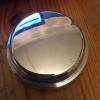Valve Guides
#1

Posted 11 February 2011 - 09:03 PM
#2

Posted 11 February 2011 - 10:08 PM
#3

Posted 11 February 2011 - 10:13 PM
#4

Posted 11 February 2011 - 11:15 PM
You knock the old guides out by pressing them in the vice first of all to get them moving, then make up a drift to knock them right through. You can make up a drift by filing the head of a 1/4" bolt down until it is circular, putting it down the guide and hitting the bolt head with a punch and mallet.
Steel guides are the best and to fit them you lightly grease the outside diameter, line each one up in turn, lay the head on its side in the vice and do it up until the guide sits at the correct height above the head upper surface. This height is noted in the workshop manual. If you put no.1 in to the correct height first, then no. 8, you can line the others up using a steel straight edge to save accurately measuring each one.
Once all 8 are installed, run a 9/32" reamer down each guide by hand (i.e.not using a power tool) and check that each valve runs with very slight clearance.
Then take the head to a local machine shop and ask them to 'kiss' the valve seats to ensure that the valves will lap-in nicely.
Lap in the valves and 'jobsagoodun'.
#5

Posted 12 February 2011 - 11:31 AM
Hone or a burnishing tool never a reamer
#6

Posted 12 February 2011 - 11:40 AM
Dont get me wrong I agree that honing is probably more accurate, but if it is such a big NO, then why does everyone do it?!
And why won't a reamer work properly if there isn't a certain amount of material? Surely if it is in good condition it will do its job?
#7

Posted 12 February 2011 - 11:47 AM
I get no end of cylinder heads brought to me that have been "reamed" one in particular had done about 200 or so miles, the head of valves could move in a forward or backward direction by up to 1.6mm, side ways by upto 1.0mm
by looking at the surface of the guide that contacts the valve it is easy to see that a reamer has been used.
Now if guides were made with a 0.010" smaller hole then yes a reamer would do a very good job if it was the correct type for the material used, ie Cast iron or Bronze.
Why use a reamer ..... because they are cheap and readily available, honing is normally carried out on dedicated machines....
A reamer needs to have an amount of material to cut and can be anywhere from 0.004" to 0.015" for this size. Normally guides are made to the exact size to fit, once you fit them they can waste down, by as much as 0.002" now a reamer needs more than this to keep it central.
Edited by mra-minis.co.uk, 12 February 2011 - 11:51 AM.
#8

Posted 12 February 2011 - 11:49 AM
#9

Posted 12 February 2011 - 11:53 AM
How about spiral fluted reamers?
In what way do you mean ?
If you are asking, will they cut differently because they are spiral then yes to a certain extent they will, however they still need that amount of material to cut properely.
#10

Posted 12 February 2011 - 12:22 PM
#11

Posted 12 February 2011 - 01:05 PM
If you have you ever used a chisel, then you will know that if the angle is too shallow it will suddenly jump out off the work piece, now the reamer will do a similar thing however it will then take a "dive" into the other side, much like a shaft that is in a loose bush
1 user(s) are reading this topic
0 members, 1 guests, 0 anonymous users

















